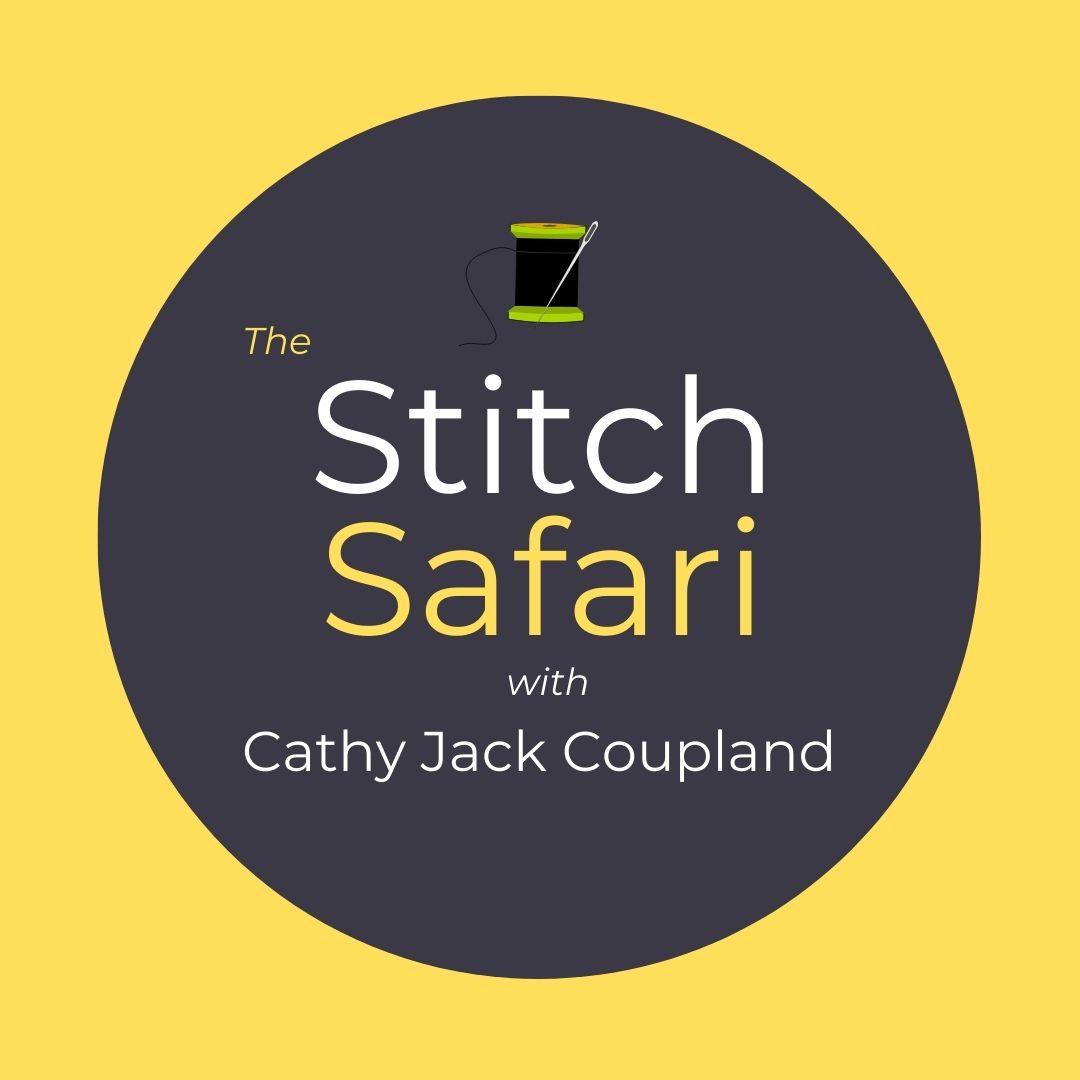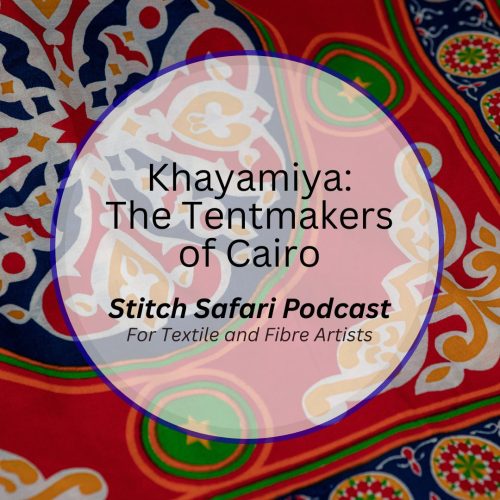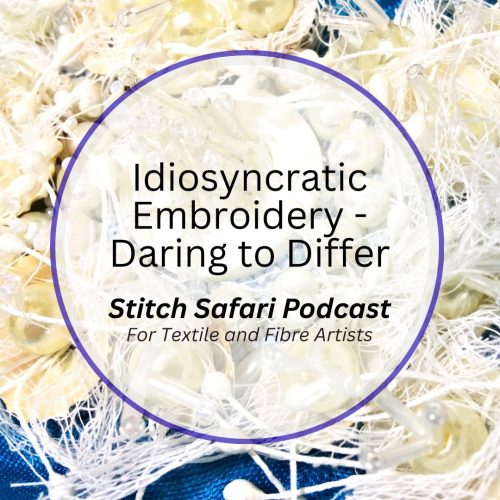In this episode of Stitch Safari, I want to look at works of art, specifically Biennale art that include embroidery and textiles to inform and give voice to social or political themes.
As always, it’s the artist’s use of visual depictions that are so powerful, expressive and emotive and so ably supported by the highly appropriate use of textiles and stitch that I felt I had to talk about in this episode – because textile and fibre art is becoming more and more popular, especially at Biennales.
I do not comment on the politics behind the work, that’s not the purpose of this Podcast, but I want to acknowledge the suffering, pain and terror behind these artworks.
It’s often that circle of women traditionally working with textiles and stitch that makes these artworks even more astonishing and resonant because they are either fully made with or include textiles, yarn, thread and stitch – adding yet another layer of meaning to their stories, that seems to complete that circle.
Women using what women are expected to know how to use seems appropriate.
Some of the artworks are intensely stitched whereas others use embroidery and fabric sparingly and judiciously to fulfil the concept – and from my perspective, both the artworks I’m going to introduce do that.
We all know art has power. It can be overwhelmingly beautiful, expressive and emotive but in these cases, it can also be a tool of resistance and solidarity.
It’s the voice that transcends boundaries to hopefully promote a form of healing while communicating these injustices to the world – simply, quietly and with great dignity.
Art is also a means of profound self-discovery, connection and awareness leading to a deeper understanding of identity, place and heritage but embroidery and textiles as art have now transcended ornamentation – as these works have done, to create work imbued with huge pathos and poignancy – so much so, they vibrate with emotion.
These artworks are exemplars that thread is resilient and unifying, connecting heritage with painful memories and histories that can and have become the voice of the abused and the marginalised.
Employing embroidery as a medium for political and social commentary affecting women is profound but it’s not new, Mary Queen of Scots and her embroideries for her cousin Elizabeth I are an example – think of the myriad associations with this traditionally feminine craft – it’s the perfect conduit into these intricate stories that define horrific moments in history.
Embroidered artistry records lived realities with quiet dignity, illustrating injustices and exposing these transgressions to the world.
These artworks make you stop and think – that’s what they’re meant to do, but they also showcase strong design that conceptualises their stories visually and expressively.
Join me in this fascinating episode of Stitch Safari as I analyse the use of textiles and embroidery in two specific artworks to communicate and record huge injustices in artworks featured in Biennales.
Stitch has now become mightier than the sword and the pen.
This episode came about because I saw an image of an artwork in the June 2024 issue of the Australian Wish magazine.
It was very abstract and compelling at first glance, but when I read the story behind the work, I found that narrative so powerful and profound that I just had to research it further.
But before I do, why Biennale art?
Because Biennale is big – it attracts large audiences and sometimes even greater attention.
So to be invited to present at a Biennale must also be a milestone for the artist involved – there’s not only pride in the work they’ve produced but pride in the country sponsoring the exhibition.
Let me read you this short passage attributed to www.fibrearts.net.au which I believe sums up Biennale perfectly.
‘Textiles have a long and memorable history and like ceramics, textiles are integrated into the history of civilisation itself. From necessity to fine art, textiles have pursued a path from providing humble warmth and protection, to plush decoration and the robes of ceremony and ritual. For years textiles languished as a collection of practical skills providing functional accoutrements. Once dismissed as ‘domestic craft,’ textiles, and the use of fibre in its various forms, are now embraced as a challenging yet accessible medium to explore cultural, environmental, political and social issues interpreted through unique and expressive gallery-welcomed artworks. The International Art Textile Biennale 2023 exhibition does this with panache.’
Textile and fibre based artworks have long been selected by various Biennales to represent and depict social, political and environmental issues – what’s appears to have changed is that they are now being openly promoted and used, along with their rich histories to give deeper meaning and value to traditions dating back eons.
Let’s not forget, stitch as an artistic form pre-dates art depicted on wooden panels or canvas.
So let’s move on to the two featured artworks that utilise either textiles or stitch or indeed, both – and they couldn’t be more different which makes them even more interesting – and what’s even more fascinating, I’ve discovered two artists whose work I admire greatly.
The first artwork is titled ‘Kiss and Don’t Tell’ a series of 25 three-metre panels by Timor Leste-born artist Maria Madeira, shown at the 2024 Venice Biennale.
The article written by Alison Kubler for Wish Magazine became the starting point for my research.
But before I read one word I was intrigued by the imagery of the artwork and the fact that embroidery was used to help convey this powerful, heart-wrenching story – that’s what caught my initial interest, the small accompanying images of textiles and stitch.
The Venice Biennale of 2024, where this artwork was shown, was a first for Timor Leste – and the artist Maria Madeira who was able to shine a light upon her fellow countrywomen – a light that exposed their suffering and bravery.
According to Kubler’s article, Venice is often dubbed the Olympics of the art universe as it commandeers the canal city, showcasing the best in contemporary art and attracting the who’s who of celebrities, curators, artists and discerning collectors.
It’s the world’s oldest and most prestigious visual arts event that began attracting huge audiences from 1895.
So while this event was a first for Timor-Leste it was monumental for Maria Madeira.
Kiss and Don’t Tell is an emotionally evocative work that sheds light on the 24-year occupation of East Timor as it was known then, by Indonesia. This brutal and bloody period was marked by torture, disappearances, sexual slavery and massacres.
Now this is history I knew nothing about, yet when I look at images of Kiss and Don’t Tell there’s a deep and dark story there, it’s compelling and it’s ably supported by the use of textiles and stitch – but that’s not all – Maria’s project also involved her performing in front of her artwork, singing traditional songs evoking yet another layer of emotion.
Madeira’s art practice is informed by personal traumas and a deep love of country and it’s worth noting that this milestone exhibition, commissioned by the Democratic Republic of Timor-Leste, coincided with the 25th anniversary of the end of Indonesian occupation.
Kiss and Don’t Tell is a large-scale installation involving a 25-panel painting three metres high – yet it exudes a quality of softness and subtlety incorporating traditional techniques and materials such as woven Timorese textiles, betel nuts, red earth from her home and pigments to tell the stories of Timorese women’s suffering.
Kubler writes that the rich red earth pigment drips and pools evoking blood and bodily fluids while gun shot wounds are expressed by chewed betel nuts spat onto the substrate – when you read the story, the imagery is profound and compelling.
A nod to her mother’s crocheting in the refugee camp is acknowledged when Madeira utilised crotched segments as a stencil – and as Kubler wrote ‘the overall effect is equal parts beautiful gestural abstraction and crime scene – precisely what Madeira sought to emulate.
Overlaying this are ‘kiss’ marks made by Madeira, who ‘performed’ during the opening days, kissing the walls with lipstick and singing traditional village songs.’
While in Dili, Timor-Lesete’s capital, Madeira stayed in a house where her bedroom had linear lipstick marks in a knee-high position around the walls – she thought this was something to do with children but was told this house was where women were brought, forced to put on lipstick and kiss the wall while being raped.
Madeira felt the walls were talking to her telling her that she had to be their voice – the kiss, normally an act of love and affection, in this case, became an act of torture.
This is a huge acknowledgement to the Timor-Leste women who suffered this injustice – a topic still not openly talked about although Madeira believes things are changing slightly.
Madeira is an activist and teacher who uses her art to convey a powerful message – Kiss and Don’t Tell is a harrowing story, yet it’s so softly wrought inviting the viewer to learn and understand its story.
Fabric appliquéd lips are interspersed with lipstick kisses along the bottom of the work, profoundly illustrating these tragic, overwhelming events – it evokes such tenderness and tragedy at the same time.
Nothing is overdone, nothing stands alone – this is clever artistry.
I rarely rave about an artwork such as this – because I find it rare that an artist melds the story, the concept, the materials and the title so completely and so well that it not only makes sense, but it makes me want to explore the story further to understand its layered meanings.
I applaud Maria Madeira for her work ‘Kiss and Don’t Tell – it brings light to the voiceless and pays homage to the suffering of the women of Timor-Leste and globally.
Now let’s move on to mixed media and assemblage artist Pacita Abad – an artist who in 1984 was the first woman to receive the Philippine’s Outstanding Young Men Award.
Again, this is an artist I’ve not heard of before, but her work is stunning.
Revered in her native Philippines since she died in 2004, Pacita’s work has drawn international acclaim – and the work I’m going to discuss here is one of her pieces from 1985 that exemplifies her style – acrylic, oil, textile collage, mirrors, shells, buttons, glass, beads, gold thread and padded cloth on stitched and padded cloth – the direct opposite to Kiss and Don’t Tell, discussed previously.
This art is intense, colourful and just as compelling.
Her painting Marcos and His Cronies was included in the 11th Berlin Biennale for Contemporary Art and is a reflection of her varied influences from African masks to Tibetan deities.
Abad was a prolific traveller and collector of textiles and techniques – you can tell just by looking at her work.
During the Marcos regime, the disparity between rich and poor and the inequalities that long plagued Philippine society swelled dramatically. His 14-year reign was marked by rampant corruption, arbitrary apprehension, detention and execution.
Marcos and His Cronies is confrontational in its political message – Abad did not hold back.
Abad was an unwavering activist who escaped political persecution during the Marcos dictatorship – she produced socio-political portraits of immigrants, refugees and other marginalised groups.
Jasmine Liu, writing for The Nation in 2024 wrote, ‘Her art integrated painting, quilting and the assemblage of Indigenous practices from around the globe to forge solidarity.’
And it seems that Abad innovated a method of trapunto that involved painting and collaging onto canvas, adding a cloth backing, then filling between the layers – the final product is a soft, textured work unconstrained by the flatness of a stretched frame – in other words, she created dimension.
Marcos and His Cronies employ her signature trapunto painting/collage technique along with hallmarks of her style – tribal artistic motifs, prolific embellishments and effervescent colour.
Marcos is depicted as the dragon demon inspired by Sri Lankan sanni masks.
18 other masks surround Marcos rendered in rich reds, yellows, greens and blues representing those who shared his greed – military generals, businessmen, and government officials.
The head of the ostentatious Imelda Marcos lays beneath the scaly feet of her husband who bares his shiny white teeth with a mouth stuffed with puppets.
This clever and intense imagery is riveting for its characterisation of Marcos and his cohort of sinful despots considering a nation suffered under this despicable dictatorship.
Marcos and His Cronies is both figurative and abstract, citing worldwide Indigenous art traditions to form solidarity between Abad and the marginalised.
She collected diverse materials along her travels – a lifelong habit and used them to express disparate struggles that explode with life and vitality.
Inspired by Phulkari from Pakistan, Mola from Panama, Ralli from Pakistan, Bangladeshi Kantha, Korean brush painting, and Indonesian shadow puppets, to name just a few, these techniques lent themselves to her developing style.
Abad educated herself and then employed these various techniques in her work.
For Abad, the avid traveller, portability was essential because she was always on the move, and textiles could be rolled and moved from place to place far more easily than work on wooden frames.
Abad’s artistic breakthrough came in the early 1980s when her interest in cultural mask traditions grew, developing her trapunto technique.
Marcos and His Cronies is a monumental work standing 17 feet high, brimming with colour, painted dots, myriad buttons, and sequins to create an unbelievable textured surface.
And its message is clear for all to see.
As I said earlier, these two artworks could not be more disparate if they tried – but they achieve the same goal – both artists used a painted canvas and both used textiles and stitch to embellish not only the canvas, but the narrative they were portraying – one achieved this sparingly with a nod to her country and traditions, the other with great intensity and creativity drawing upon myriad cultures and traditions.
In my opinion, these two artists are well worth further research – Maria Madeira and Pacita Abad.
Both have websites and both utilise culture and heritage to express their messages.
Both create impactful art and both use textiles and stitch to do so.





